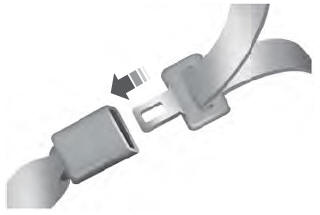Lincoln Aviator: Body Repairs - General Information / Description and Operation - Sealer, Underbody Protection Material and Adhesives
Adhesives
The correct adhesive bonding is essential to repairing the vehicle correctly. Adhesives and mechanical fasteners are used in certain areas of the body structure in place of welding. In addition to providing a structural bond between components, adhesives can also help prevent wind noise, water leaks, exhaust fumes and dust from entering the vehicle. They also provide anti-corrosion barriers.
Refer to specific component removal and installation procedures for correct application and location of adhesives.
Sealers
The correct sealing of joints is essential to repairing the vehicle correctly. Sealers are used to prevent wind noise, water leaks, exhaust fumes and dust from entering the vehicle. They also provide anti-corrosion barriers. Sealers are applied to areas such as doors hem flanges, wheelhouse, floor, cowl, roof and other panel-to-panel attaching point seams.
Sealers should remain flexible after curing and must be paintable. Follow the manufacturer's directions for correct application of these materials.
Any damage to originally sealed joints should be repaired by resealing. Along with attaching points of new panels, open joints that require bridging of sealer to close a gap should be sealed using a heavy-bodied sealer.
NOTE: The following illustrations are examples of sealer and adhesive application and are not all inclusive.
NOTE: Left hand side shown, right hand side similar.
Hood Sealer
.jpg)
Front Door Sealer
.jpg)
Rear Door Sealer
.jpg)
Liftgate Sealer
.jpg)
Body Sealers and Adhesives Overview
.jpg)
Front Structure Sealers and Adhesives Overview
.jpg)
NVH Protection Material
NVH protection is necessary for road noise reduction. In the case of floor panel application, it also serves as a form of underbody heat control. It is paintable, very durable and has good resistance to abrasion. This material may be applied in many manners. It may be applied through the use of butyl patches, sprayed, rolled or brushed on (obtain locally).
Floor Pan
.jpg)
Front Door
.jpg)
Rear Door
.jpg)
 Description and Operation - Plastic Repairs
Description and Operation - Plastic Repairs
Plastic Components
NOTE:
Left hand side shown, right hand side similar.
The
following illustration is not all-inclusive of trim levels available...
 General Procedures - Corrosion Prevention
General Procedures - Corrosion Prevention
Special Tool(s) /
General Equipment
Rust Protection Coating Gun
Undercoating Gun
Materials
Name
Specification
ValuGard™ Premium UndercoatingVG101, VG101A
-
ValuGard™ Rust InhibitorVG104, VG104A
-
Motorcraft® Metal Surface Prep WipesZC-31-B
-
Repair
NOTE:
Undercoating
NOTE:
The following illustrations are not vehicle specific and are intended for reference only...
Other information:
Lincoln Aviator 2020-2025 Service Manual: Removal and Installation - Third Row Seat Backrest
Special Tool(s) / General Equipment Interior Trim Remover Removal WARNING: The following procedure describes critical repair steps required for correct seat component installation. Follow all notes and steps carefully. Do not place any objects between the seat components and the body of the vehicle, nor any objects within a joint internal to the seat structure...
Lincoln Aviator 2020-2025 Owners Manual: Economical Driving
Your fuel economy is affected by several things, such as how you drive, the conditions you drive under, and how you maintain your vehicle. You may improve your fuel economy by keeping these things in mind: Accelerate and slow down in a smooth, moderate fashion...
Categories
- Manuals Home
- Lincoln Aviator Owners Manual
- Lincoln Aviator Service Manual
- Changing the Front Wiper Blades - Vehicles With: Heated Wiper Blades
- Wireless Accessory Charger (If Equipped)
- Interior Lamps
- New on site
- Most important about car
Fastening the Seatbelts
The front outboard and rear safety restraints in the vehicle are combination lap and shoulder belts.
Insert the belt tongue into the proper buckle (the buckle closest to the direction the tongue is coming from) until you hear a snap and feel it latch. Make sure that you securely fasten the tongue in the buckle.
